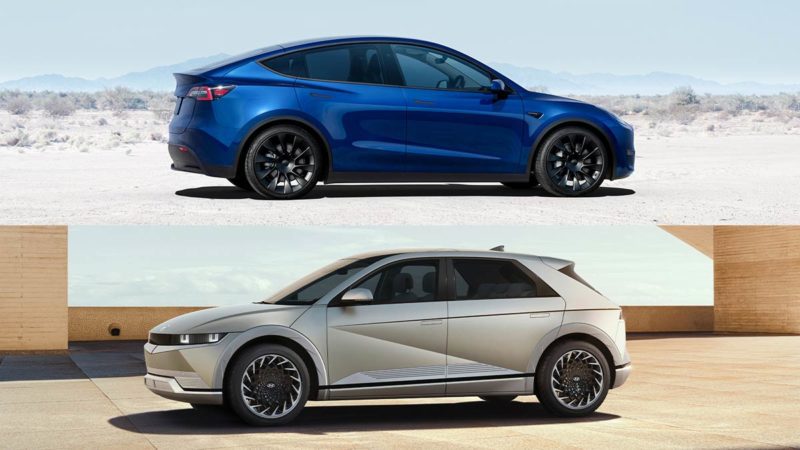The Driven had a chance to view the Tesla Model Y when it went on display in Tesla show-rooms and orders opened on Thursday in Australia.
As we reported here and here, the Model Y is remarkably different from its electric sedan stablemate, the Model 3. We haven’t had the opportunity to report on how it drives, but there’s lots to say about its look, interior and specs.
What was surprising to me was the similar spaciousness of the Model Y and the Hyundai Ioniq 5, which last year won many awards for “Car of the Year”. Getting in the Model Y there is a similar tardis-like experience to that of the Hyundai Ioniq 5. See The Driven editor Giles Parkinson’s review of the Ioniq 5 here, and also mine here.
Of course, the big difference between the two is availability. While Hyundai has only been able to secure several hundred of the Ioniq 5 for the local market in 2022, Tesla will likely ship thousands of Model Ys to Australia by the end of the year.
Demand for both is high. Windows for ordering the Ioniq 5 have been short, as tranches of a hundred or so vehicles at a time sell out within minutes.
By comparison, we estimated Tesla took more than 11,000 orders for the Model Y within the first few days of sale. Interest was so great that even Musk weighed to say Tesla would look at making more for right-hand-drive markets.
So how do the two electric crossovers weigh up?
Model Y versus Ioniq 5 specifications
Priced from $68,900 for the RWD Model Y compared to $71,900 for the RWD Ioniq 5, the two differ on key specs like range and acceleration. Additionally, there is a significant difference in pricing between the AWD Performance Model Y and the AWD Ioniq 5 (notably, the Long Range Model Y is not available locally for the moment.
Basic spec comparison as as so:
| Manufacturer | Tesla | Hyundai | Tesla | Hyundai |
| Model Name | Model Y | IONIQ 5 | Model Y | IONIQ 5 |
| Variant Name | RWD | Long Range 2WD | Performance AWD |
Long Range AWD
|
| Price | $68,900 | $71,900 | $93,900 | $75,900 |
| Acceleration | 6.9 s | 7.4 s | 3.7 s | 5.2 s |
| Top Speed | 217 km/h | 185 km/h | 241 km/h | 185 km/h |
| Torque | 420 Nm | 350 Nm | 660 Nm | 605 Nm |
| Power | 255 kW | 160 kW | 377 kW | 225 kW |
| Efficiency | 139 Wh/km | 161 Wh/km | 181 Wh/km | 169 Wh/km |
| Range WLTP (Comb) | 420 km | 430 km | 400 km | 451 km |
Model Y versus Ioniq 5 dimensions
At first glance, the two are remarkably similar in size. However, there are some key dimensions that differ.
According to carsized, the Model Y is 1.9cm higher than the Ioniq 5 (162.4cm compared to 160.5cm). It is also significantly longer by 11.5cm (475cm compared to 463.5cm), and 8.8cm wider (197.8cm compared to 189cm).
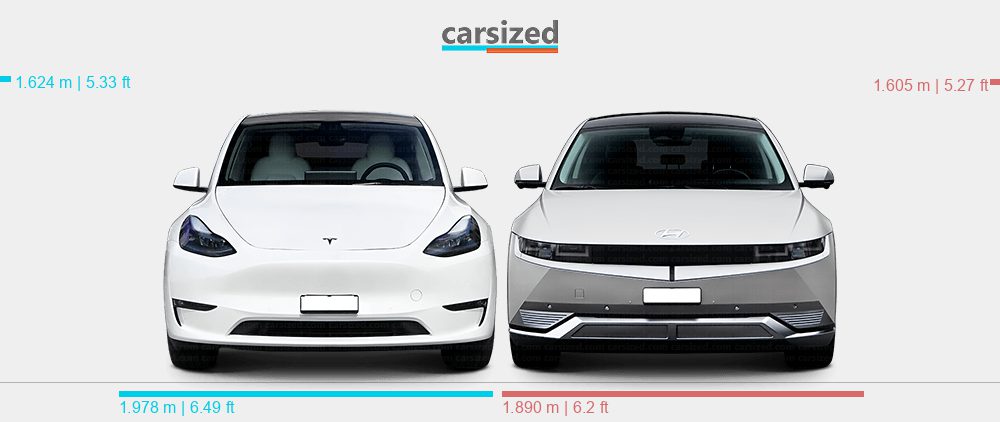
From the back, the Model Y also appears bigger, with the top bottom of the rear window visibly higher. At the same time, it also has slightly more ground clearance – although not by much. The ground clearance of the Model Y is 167mm compared to the Ioniq 5’s 160mm.
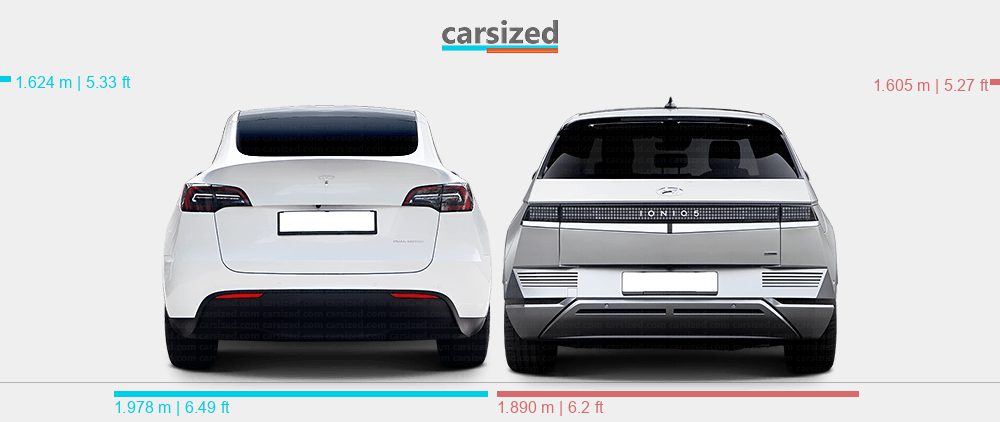
Model Y versus Ioniq 5 interior and connectivity
Inside, both have a minimalist design, although undoubtedly this zen contest is won by the Tesla Model Y. It has just one touchscreen and no extra display, while the Ioniq 5 has both. The Ioniq 5 also has a number of dashboard buttons to access vehicle controls, which can then be manipulated via the touchscreen.
The two both have loads of legroom both in the front and back row. Although it’s not available in Australia, there is a seven-seater option for the Model Y (unlike the Ioniq 5.)
One noticeable difference in the front row of both vehicles is the centre console. In the Ioniq 5, it is separate from the dash and can be moved back and forwards with a hidden level at the front top of the unit. As a result, there is a lot of room to place bags and other items.
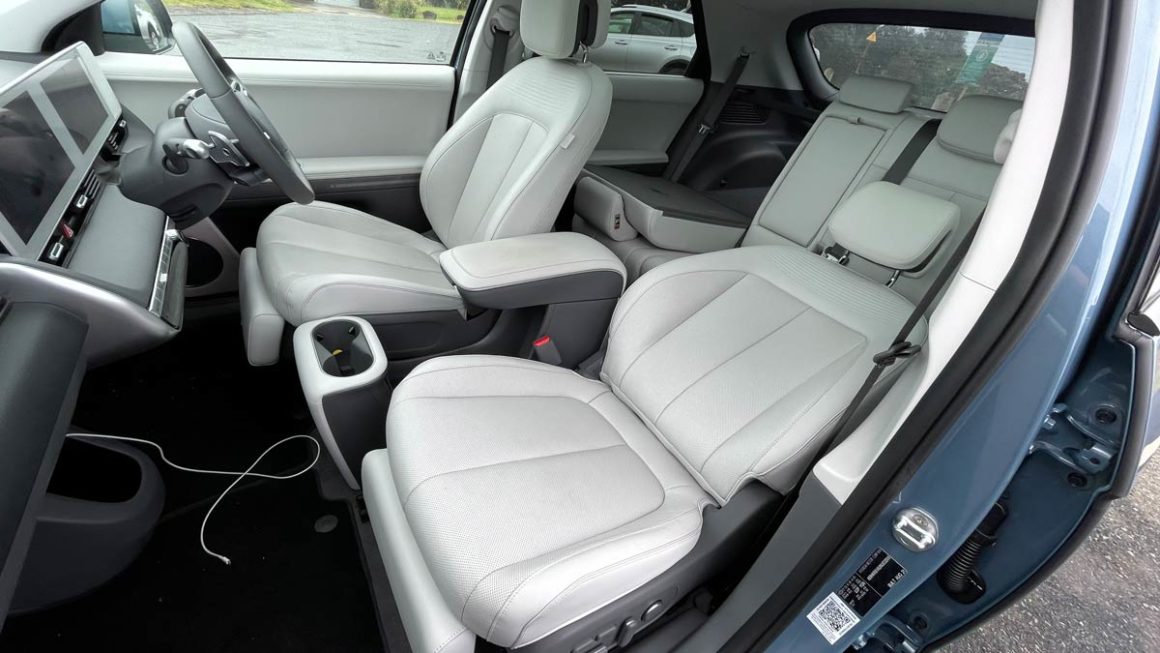
In the Model Y, the centre console is connected to the dash. There is more limited space for bags and other items.
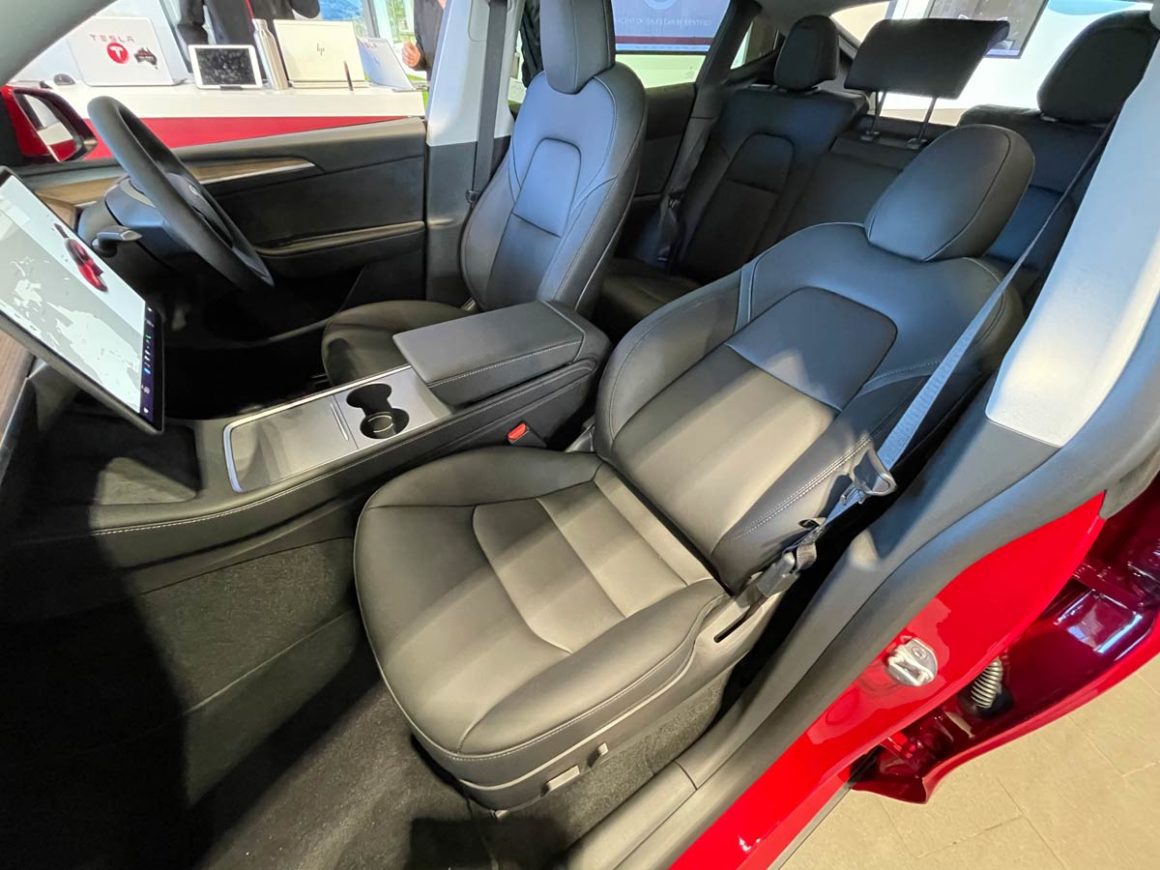
The two also differ on connectivity. The Ioniq 5 has USB-A ports, and it is possible to connect your smartphone to the Ioniq 5 via a USB cord (see above). The USB ports are located at the bottom of the centre console, and below the dash as well as in the back of the centre console.
The Model Y in contrast has USB-C ports, two of which are inside the centre console storage area and on the back of the centre console for back row access. There is also a USB-A port in the glove box for the Sentry Model USB stick.
Both have a 12-volt power outlet, with the Ioniq 5’s located below the dash, and the Model Y’s located in the centre console storage area.
Model Y versus Ioniq 5 interior and cargo space
The Model beats the Ioniq 5 hands down in terms of cargo space. With 853 litres in the back (1,925 litres with the seats down), it has much more cargo space compared to the Ioniq 5, which has 531 litres and 1,587 litres with the seats folded down.
In the front storage area underneath the bonnet (known as a “frunk”), the Model Y also wins hands down. It has 117 litres worth of space under the bonnet, while the Ioniq 5 has just 24 litres in the AWD variant, and 52 litres in the RWD.
Model Y versus Ioniq 5 specifications
Model Y versus Ioniq 5 charging and V2L
Although Hyundai likes to spruik its superior ultra-fast charging thanks to an 800-volt architecture, the Ioniq 5 can in fact only charging minimally faster than the Model Y (220kW top charge rate compared to 210kW).
But, it beats the Model Y on the fact that, like the Kia EV6, it as vehicle-to-load capacity. This means it can be used to power devices from a normal household socket via an adapter on the external socket, including those in your home in case of a power outage.
Model Y versus Ioniq 5 specifications
You can compare the full gamut of specifications of the Model Y and Ioniq 5 here:
| Manufacturer | Tesla | Hyundai | Tesla | Hyundai |
| Model Name | Model Y | IONIQ 5 | Model Y | IONIQ 5 |
| Variant Name | RWD | Long Range 2WD | Performance AWD |
Long Range AWD
|
| NCAP | – | 5 | – | 5 |
| Price | $68,900 | $71,900 | $93,900 | $75,900 |
| Country of manufacture | China | South Korea | China | South Korea |
| Acceleration | 6.9 s | 7.4 s | 3.7 s | 5.2 s |
| Top Speed | 217 km/h | 185 km/h | 241 km/h | 185 km/h |
| Torque | 420 Nm | 350 Nm | 660 Nm | 605 Nm |
| Power | 255 kW | 160 kW | 377 kW | 225 kW |
| Drive Type | Rear | Rear | AWD | AWD |
| Efficiency | 139 Wh/km | 161 Wh/km | 181 Wh/km | 169 Wh/km |
| Battery Capacity | 62.3 kWh | 77.4 kWh | 82 kWh | 77.4 kWh |
| Battery Useable | 60 kWh | 72.6 kWh | 76 kWh | 72.6 kWh |
| Charge Port Location(AC) | Left Side-Rear | Right Side-Rear | Left Side-Rear |
Right Side-Rear
|
| Charge Rate (DC) | 210kW | 220kW | 210kW | 220kW |
| Charge Rate (AC) | 11kW AC | 11kW AC | 11kW AC | 11kW AC |
| Charge Time (AC) | 6 hr 2 min | 7 hr 45 min | 7 hr 45 min | 7 hr 45 min |
| Charge Speed (AC) | 62km/h | 50km/h | 52km/h | 48km/h |
| FCP Locaiton (DC) | Left Side – Rear | Right Side – Rear | Left Side – Rear |
Right Side – Rear
|
| Fast Charging Time (DC) | N/A | N/A | N/A | N/A |
| Fast Charge Speed (DC) | N/A | N/A | N/A | N/A |
| Range WLTP (Comb) | 420 km | 385 km | 400 km | 375 km |
| Energy WLTP (Comb) | 167 Wh/km | 189 Wh/km | 181 Wh/km | 194 Wh/km |
| Seats | 5 | 5 | 5 | 5 |
| Body Style | SUV | SUV | SUV | SUV |
| Tow Hitch Avaliability | Yes | Yes | Yes | Yes |
| Frunk Capacity | 117 L | 52 L | 117 L | 24 L |
| Cargo Capacity | 853 L | 531 L | 853 L | 531 L |
| Max Cargo Capacity | 1925 L | 1587 L | 1925 L | 1587 L |
| Wheel Base | 2890 mm | 3000 mm | 2890 mm | 3000 mm |
| Curb Weight | 2003 kg | 1985 kg | 2072 kg | 2095 kg |
| Dimensions | 4751x1624x1921 mm | 4635x1605x1890 mm | 4751x1624x1921 mm |
4635x1605x1890 mm
|
| V2L | No | Yes | No | Yes |
| EV Dedicated Platform | Yes | Yes | Yes | Yes |
| Ground Clearance | 167mm | 160mm | 167mm | 160mm |
| Turning Circle | 12.1 m | 12 m | 12.1 m | 12 m |

Bridie Schmidt is associate editor for The Driven, sister site of Renew Economy. She has been writing about electric vehicles since 2018, and has a keen interest in the role that zero-emissions transport has to play in sustainability. She has participated in podcasts such as Download This Show with Marc Fennell and Shirtloads of Science with Karl Kruszelnicki and is co-organiser of the Northern Rivers Electric Vehicle Forum. Bridie also owns a Tesla Model Y and has it available for hire on evee.com.au.


